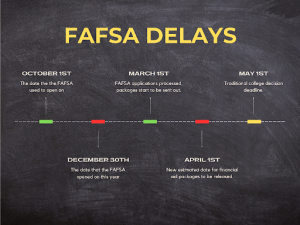The new FAFSA rollout has been riddled with many issues, including three-hour hold times, glitches and bugs in the website, and frequent maintenance. Many students have been left in the dark about solutions to their problems regarding the FAFSA form, and a new processing date of mid-March has forced prospective college students all over the U.S. to wait longer than usual to get their financial aid packages.
Last year, the U.S. Department of Education announced that they would redesign the FAFSA to increase students’ and parents’ access to financial aid from the federal government. The Free Application for Federal Student Aid (FAFSA) is a form used to distribute federal money to students who need assistance paying for college.
“In previous years, the FAFSA would open in October, and financial aid packages would be able to be generated in January,” says Douglas Grando, a guidance counselor at Hendrick Hudson High School. However, the Department of Education announced in the summer of 2023 that the FAFSA would open in late December, with the goal that the improved FAFSA form would allow them to process the applications before February 1st.
The Department of Education was incorrect about the timeline. Now that students won’t get their FAFSA forms processed until March, they will not get their financial aid packages until at least late March/ early April.

Students who rely on need-based aid to afford higher education will not know if they can afford the schools they got into, and those who do get their financial aid packages have a short time to decide before the usual commitment deadline of May 1st. “When packages come out in January, as they usually do, students have ample time to not only decide, but to travel to the schools they got into as well” says Grando. Now families are working with a shorter time frame for decisions and will be forced to make financial decisions sooner rather than later.
Another portion of the FAFSA that sought improvement was the communication part of the application process. Thousands of applicants make mistakes and typos in the FAFSA form every year, and the Department of Education has been inconsistent with solutions to these problems. On the FAFSA website, studentaid.gov, they told students that mistakes could be fixed after the applications could be processed, but now that the processing deadline has been pushed to March, mistakes will stay in the system for much longer. This, plus 3 hour holding times, glitches and bugs in the website and frequent maintenance have deterred many students from dealing with the FAFSA at all.
These delays interfere with colleges and universities as well, who usually have ample time to plan and coordinate their financial aid programs. Most universities in the U.S rely on the data in the FAFSA to decide how much money to give to students. Now that they are being denied data until March, they have less time to process the applications and distribute their money to students.
It is important to note that universities will still distribute the same amount of aid as they usually do– the new timeline only guarantees that students have less time to make a decision. Some institutions have also pushed back their decision deadline from May 1st to June 1st, or some have suspended the deadline indefinitely.
In addition to FAFSA, private institutions also utilize the CSS Profile, a financial aid application run by the College Board, the same organization that runs the SAT, ACT and AP classes. The CSS Profile is similar to the FAFSA in that it is a financial aid form, but the application process for the CSS is much longer than the FAFSA, and the CSS Profile is for institutional money, not federal. The CSS Profile is not used by all colleges, typically in state schools and public universities
The delays on the FAFSA form have affected both schools and students negatively, and all parties are undergoing high levels of stress trying to figure out how to work the FAFSA. “Our biggest problem as guidance counselors is the wait time. It’s affecting the students’ ability to compare financial aid packages in a timely manner. We’re here to help, but the truth is it’s a more complicated year than most when it comes to the FAFSA,” said Grando.








